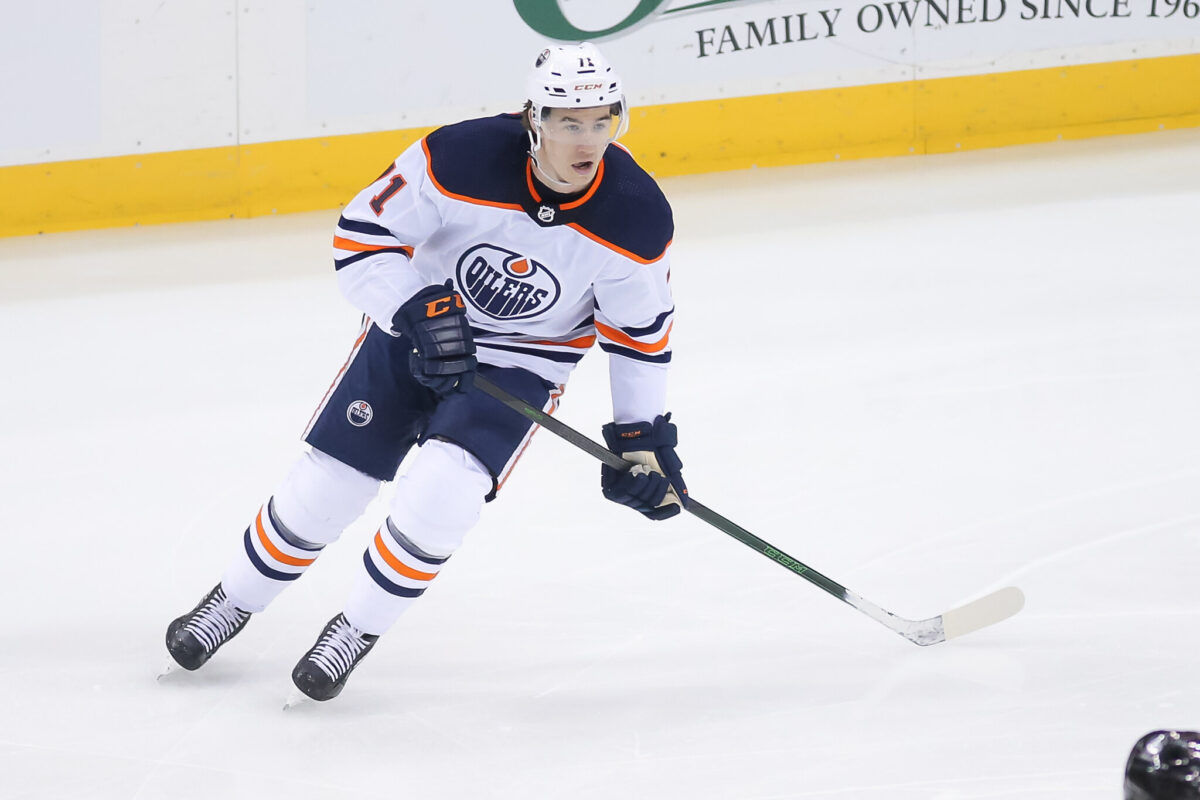The Edmonton Oilers have two key restricted free agents (RFA) that they still need to sign, Evan Bouchard, and the focus here today, Ryan McLeod. With nearly $6.5 million to re-up the two and one more unrestricted free agent (UFA), it’s looking very clear it’ll have to be short-term deals for everyone. This isn’t ideal since the cap will go up next year, which will allow these players to ask for more on their next contracts.
McLeod isn’t going to get as much per season as Bouchard, likely half the amount on a short-term deal or even less. He still has to prove he’s worth the investment. All signs point towards a pending breakout campaign, but there isn’t much room for him to be promoted above the third line. The Oilers need depth anyway, so if he can somehow put it all together this season, the team might have a young player with 2C potential as their third-line centre (from “Rising young pivot represents another tricky negotiation for Edmonton Oilers,” Edmonton Journal, June 1, 2023).
McLeod’s Comparables & Regular Linemates
The Oilers got McLeod re-signed last offseason on an amazing one-year, prove-it deal at $800,000. This year, they’re not going to get so lucky as that type of contract can only get handed out so often to a young player who deserves more. The Oilers were in an even tighter spot last season when he signed, so with a bit more money to work with, he will get a larger portion of the spoils.

As a third-liner, McLeod doesn’t have top-tier wingers playing alongside him. His most common linemates last season were Derek Ryan, Warren Foegele, and Mattias Janmark. None of them are top offensive producers to help McLeod reach his offensive potential yet. But hear me out, that could be a good thing. While cap space is very tight, and the Oilers now have four top-six wingers, McLeod can do his thing on the third line, learning from playing below Connor McDavid and Leon Draisaitl.
When the time is right, McLeod will have the chance to get some playing time in the top-six if he deserves it. Moving him up will involve the team having a solid third-line centre option to replace him, though, but that won’t happen this season. If the Oilers elevate him and see him break out right after a longer-term extension gets signed, then all arrows should be pointing up. They would be betting on a player in the hopes that his contract will turn out to be very good for the team before it expires.
Related: Grading the Oilers’ Start to 2023 Free Agency
According to Natural Stat Trick and Money Puck, McLeod has strong analytics. He’s averaged 1.85 points per 60 minutes at five-on-five, which is comparable to players like Mark Scheifele, Dylan Larkin, Martin Necas, and William Karlsson. Obviously, McLeod isn’t at their level, as he plays lower in the lineup, doesn’t get as much playing time, and doesn’t play with the top players on the team (from “Lowetide: Oilers centre Ryan McLeod’s comparables and career trajectory”, The Athletic, Feb. 17, 2023). But this is just a small glimpse at what could be if everything goes right. He scored 23 points in 57 games last season, with 20 of them coming at five-on-five and the other three shorthanded. Of the 20 five-on-five points, 17 were primary, meaning he’s more involved in the goal when his line scores.
What McLeod Does Well & Can Improve Upon
McLeod is very efficient at his position, despite the points not going in at as high of a rate as he and the Oilers would like…yet. There were over 200 centres who logged at least 500 minutes last season, and the Oilers’ third-line centre ranked very impressively amongst them in some key analytical categories. He was 37th in Corsi for percentage (CF%) at 53.94 percent, 32nd in expected goals for percentage (xGF%) at 55.35 percent, 26th in scoring chances for percentage (SCF%) at 55.89 percent, and 11th in high danger chances for percentage (HDCF%) at 59.45 percent.

So what does that mean? His speed and decision-making ability create a lot of good chances compared to what opponents do against him while on the ice. This also speaks to his defensive ability, which is why he’s used on the penalty kill a lot.
Given his speed and the time spent handling the puck, he should draw more penalties. Although he took just eight minor penalties this season, he only drew six. Since he handles the puck a lot, you should expect giveaways, but his giveaways are much higher than takeaways for a forward, and that’s not normal. That could definitely improve. He does everything well in the defensive end, but his faceoff percentage also needs improvement. This is why he isn’t trusted to start as many draws in his own end. For a strong defensive player, the team is therefore forced to play someone who is strong at faceoffs on the wing to take defensive zone draws (Derek Ryan) or limit his defensive zone draws, which also limits his time in the defensive zone.
McLeod is young, so I wouldn’t expect him to be an expert in drawing penalties just yet. He can work on faceoffs and giveaways/takeaways since he has the tools to be very good, and his positives greatly outweigh his negatives.
So, why will McLeod’s next contract be a steal for the Oilers? One way or the other, his AAV will still be low, for this coming season at least. Both sides know cap space is limited, and his career highs are just 11 goals and 23 points. There is a ton of upside to him, but his offensive production is restricting him from getting a higher cap hit. The longer term almost always means a lower-cap hit, but I’m not certain he would go for that right now, as he’s on the cusp of breaking out. The top power-play unit does all the heavy lifting, so he won’t boost his numbers in that regard.
His upcoming contract should top out at $2.25 million for 1-2 years. With a full season and another year of experience, he could definitely hit 15-20 goals and 35-plus points. The contract after that will be the problem. The window to win is right now for the Oilers, and while it’s good to think about the future, that’s not a luxury they can afford.
